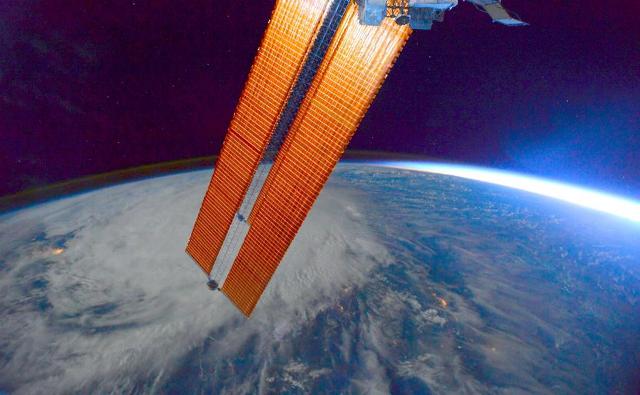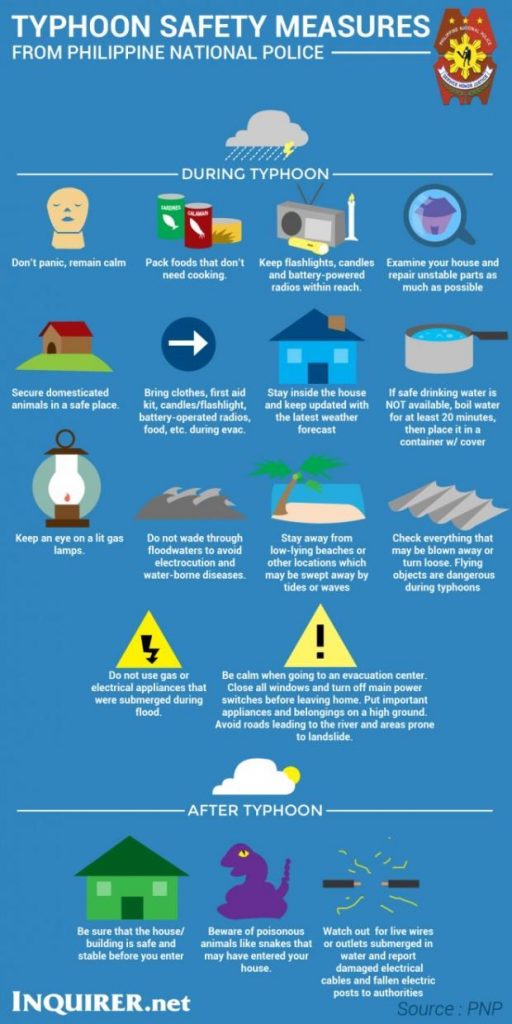Typhoon Safety Tips from DOH and PNP

The Philippines is battered by an average of 19 typhoons per year where about 6 to 9 of them make landfall. Thus, typhoon is the natural disaster that causes the most damage on both life and property in the country. Although we cannot alter the fact that numerous typhoons will pass our country, we can make necessary preparations to reduce possible damages. To begin with, here are a few typhoon safety tips from the Department of Health (DOH).
1. Water is an essential life resource. During typhoon season:
- Make sure drinking water is from a safe source.
- When in doubt, do not drink. Boil it for 3 minutes or chlorinate drinking water to make it safe.
2. Having a proper food stock is important during typhoon season. Still, keep in mind:
- Food should be well-cooked.
- Left-overs should be covered and kept away from household pests.
- Food waste should be disposed properly.
3. Having proper clothing is crucial during a typhoon. Keep yourself dry and warm.
4. Others reminders to keep in mind:
- Consult a doctor at once if you, or any member of your household, have any sign or symptom to prevent the spread of infection in the evacuation area.
- Common infections or diseases that may spread in an evacuation area include: coughs and colds, acute gastroenteritis, skin and eye infections, measles, dengue, leptospirosis, hepatitis A.
- Do not allow children wade in floodwaters to avoid diseases such as leptospirosis.
- Dispose all waste properly.
- Maintain personal hygiene, always wash your hands before and after eating and using the toilet.
- Put safety first. Avoid hanging wires and unstable structures.
Aside from these reminders from DOH, the Philippine National Police (PNP) also has its set of typhoon safety tips.
During a typhoon:
1. Do not panic, remain calm.
2. Pack foods that don’t need cooking.
3. Keep flashlights, candles and battery-powered radios within reach.
4. Examine your houses and repair unstable parts as much as possible.
5. Secure domesticated animals in a safe place.
6. Bring clothes, first-aid kit, candles/flashlights, battery-operated radios, food, etc. during evacuation.
7. Stay inside the house and keep updates with the latest weather forecast.
8. If safe drinking water is NOT available, boil water for at least 20 minutes, then place it in a container with cover.
9. Keep an eye on lighted gas lamps.
10. Do not wade through flood waters to avoid electrocution and water-borne diseases.
11. Stay away from low-lying beaches or other locations which may be swept away by tides or waves.
12. Check everything that may be blown away or turn loose. Flying objects are dangerous during typhoons.
13. Do not use gas or electrical appliances that were submerged during flood.
14. Be calm when going to an evacuation center. Close all windows and turn off main power switch before leaving home. Put important appliances and belongings on a high ground. Avoid roads leading to the river and areas prone to land-slide.
After typhoon:
1. Be sure that the house/ building is safe and stable before you enter.
2. Beware of poisonous animals like snakes that may have entered your house.
3. Watch out for live wires or outlet immersed in water and report damaged electrical cables and fallen electric posts to authorities.
Do you have other typhoon safety tips?
Share them with us.
Typhoon Safety Tips from DOH and PNP





